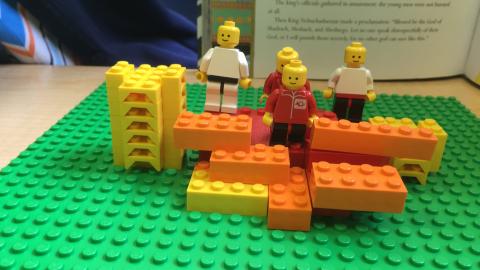Children's Ministry, Faith Nurture
Toy Story: How We Used Lego in Summer Children’s Ministry
3 comments
618 views

Summertime is a wonderful annual break in the routine of the school year, so for summer children’s ministry lessons I usually do something a little different. Since we use people who have not taught during the preceding year, I plan lessons that don’t require additional training. The lesson is often from picture books, such as:
The leaders read a book aloud and then discuss the images and story with the kids.
But this year I tried something new. In a blog post from Building Faith, Emily Given suggesting using Lego™ as a response to the story. I was skeptical that it would work well, but since Lego are so popular (especially with my sons-in-law) I decided I needed to try it.
The article, which includes a basic session outline, lists one important guideline that makes this work for me: kids must build part of the story and retell the story before they make any other Lego creations.
For this trial I used my family’s Lego collection from home. I purchased enough Lego 10x10-inch classic base plates so we’d have one per child (check Amazon.com for Lego-compatible base plates at about half the price of the name brand). I gathered as many Lego people figures as possible—the kids don’t care how the figures are dressed.
So how did it work? The kids loved it. The leader read the story from a Bible storybook and the kids built a scene from the story. The children explored the story in a new way and retold it to each other as they were building. The kids who finished early grabbed another base plate and started another scene from the story.
And best of all, using Lego was a great equalizer for the kids, whether they were new to hearing Bible stories or had been hearing them all their life.
The leader took pictures of the creations, and the pictures were placed on display for the congregation to guess the stories. Since we had a picture of each child’s creation, they didn’t have a problem with taking the creations apart and starting again the following week. You can also send the pictures home with the children and encourage them to tell the story to their families.
By trying this for three weeks this summer, the kids were able to explore the Bible stories in a new way. They also could tell the story to the children and leaders in their worship center, their congregation, and the people in their home. This was much more than I expected!
Telling stories with Lego could also work well in Wednesday night programs, at intergenerational events, or at home for family devotions.
Have you tried using Lego in your children’s ministry programs? What did you do? How did it work?
GEMS, Children's Ministry
GEMS, Children's Ministry
Children's Ministry, Faith Nurture
Children's Ministry, Disability Concerns
Connect to The Network and add your own question, blog, resource, or job.
Add Your Post
Comments
Lego, like sheep.
Ha, good catch, Hetty! "Lego" is indeed the plural. We'll fix this.
We're at the end of our second summer doing Lego response time, but without base plates--I'm going to check out Amazon for them next summer. We love it! There's something beautiful and holy about the few minutes that everyone has their Lego and their heads are bent over them, working on their creation. The 3-year-olds aren't as engaged as the older kids (we have 3-2nd grade together in the summer), but some kids keep working on Lego the whole time instead of going out to the playground. This summer, one girl suggested that everyone work together to make a model of heaven on the last Sunday; turns out that she wanted everyone to make *her* vision of heaven ;-)
Let's Discuss
We love your comments! Thank you for helping us uphold the Community Guidelines to make this an encouraging and respectful community for everyone.